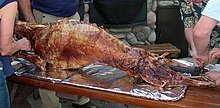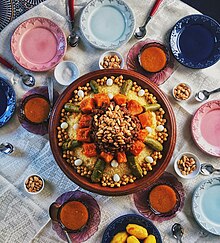The cuisine of North Africa, also known as Maghrebi cuisine, is shaped by the Mediterranean and desert climate. Influences from the Levant starting no later than the Arab invasions and arguably as early as the Phoenician colonies, and more recently from the Ottoman Empire, have brought similarities to Middle Eastern cuisine. However, there are quite a few differences, and many of the people in this region are Berbers, rather than Arabs, with their own traditions.
While influenced by French cuisine due to French colonization, Maghrebi cuisine has in turn been successful in France, largely owing to North African immigration to France.
Dishes
[edit]


As pork is taboo in Islam, the most popular meats are beef, sheep, goat, and poultry.
Traditional spices are cumin, ginger, paprika, cinnamon, and saffron.
The archetypal staple food is couscous. Wheat bread is also ubiquitous. Aside from couscous (not just the grain but a meat with sauce, vegetables and couscous), tagines are a typical dish.
There are many North African mezes, and quite a few of them are distinct from common Levantine mezes - for example, spicy carrots. In this region, harissa is a fiery red chili-based sauce with a unique mixture of spices.
Beverages
[edit]Alcoholic beverages are restricted, but can still be bought and consumed in most resort towns. Wine is also made by the Jewish minority for sacramental use.
The restrictions on alcohol, and the hot climate, make soft drinks and fruit juices popular.
Green tea with mint has status of national beverage in Morocco.

